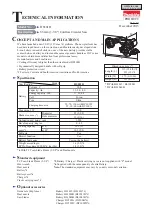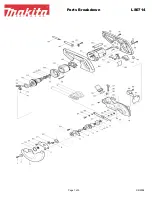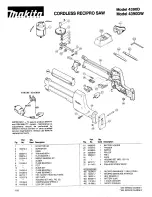
English
11
Fig. K
1
4
Cutting (Fig. A, K, L)
Refer to Figure L for recommended cutting positions for
various materials.
nOTE:
Select and use a band saw blade that is
most appropriate for the material being cut. See
Blade Description
.
This portable band saw may be hung using the hang hook
(
13
, Fig. A). Hang tool on a pipe vise or other suitable,
stable structure.
WARNING:
To reduce the risk of injury, only use hang
hook to support the weight of the tool. Never rely on
the hang hook for your own support or to help you
maintain your balance.
WARNING:
Never attempt to use this tool by resting
it upside down on a work surface and bringing
the material to the tool. Always securely clamp
the workpiece and bring the tool to the workpiece,
securely holding the tool with two hands as shown
in Figure K.
1. Mount the material to be cut solidly in a vise or other
clamping device.
2. Bring the work stop
5
into contact with the workpiece
while keeping the blade off of the workpiece. Turn the
saw on.
3. When saw reaches desired rotation speed, slowly
and gently tilt the main body of the tool to bring the
band saw blade into contact with the workpiece. Do
not apply additional pressure in excess of the weight
of the main body of the tool. Carefully avoid bringing
the band saw blade suddenly and heavily into contact
with the upper surface of the workpiece. This will cause
serious damage to the band saw blade. To obtain
maximum service life of the band saw blade, ensure
there is no sudden impact at the beginning of the
cutting operation.
4. As shown in Figure K, straight cutting can be
accomplished by keeping the band saw blade aligned
with the side surface of the motor housing. Any twisting
or cocking of the blade will cause the cut to go offline
and decrease the life of the blade.
NOTICE:
During cutting, if the band saw becomes
locked or jammed in the workpiece material, release
the switch immediately to avoid damage to the band
saw blade and motor.
5. The tool’s own weight provides the most efficient
downward cutting pressure. Added operator pressure
slows the blade and reduces blade life.
6. End pieces, which would be heavy enough to cause
injury when they drop, after cut-off, should be
supported. Safety shoes are strongly recommended.
End pieces may be hot and sharp.
7. Whenever possible, hold the saw firmly in both hands.
8.
DO nOT MAKE AnY sPEED ChAngEs UnlEss TOOl
hAs BEEn TURnED OFF.
Tips for Better Cutting
The following recommendations (Figure L) should be used
as a guide. Results may vary with the operator and the
particular material being cut.
• Never twist the band saw blade during
cutting operation.
• Never use liquid coolants with portable band saws.
Use of liquid coolants will cause build-up on tires and
reduce performance.
• If excessive vibration occurs during the cut, ensure that
the material being cut is securely clamped down. If
vibration continues, change the band saw blade.
YES
NO
Recommended Cutting Positions
YES
YES
YES
YES
YES
NO
NO
NO
NO
NO
Fig. L
MAINTENANCE
WARNING: To reduce the risk of serious personal
injury, turn unit off and remove the battery pack
before making any adjustments or removing/
installing attachments or accessories.
An
accidental start-up can cause injury.
Cleaning
WARNING:
Blow dirt and dust out of all air vents with
clean, dry air at least once a week. To minimize the risk
of eye injury, always wear ANSI Z87.1 approved eye
protection when performing this.














































